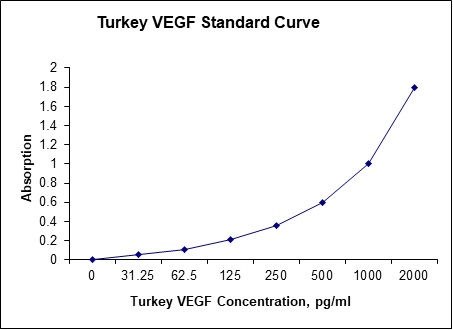Nori Turkey VEGF-A ELISA Kit
$461.00 – $832.00
This ELISA kit is for quantification of VEGF-A in turkey. This is a quick ELISA assay that reduces time to 50% compared to the conventional method, and the entire assay only takes 3 hours. This assay employs the quantitative sandwich enzyme immunoassay technique and uses biotin-streptavidin chemistry to improve the performance of the assays. An antibody specific for VEGF-A has been pre-coated onto a microplate. Standards and samples are pipetted into the wells and any VEGF-A present is bound by the immobilized antibody. After washing away any unbound substances, a detection antibody specific for VEGF-A is added to the wells. Following wash to remove any unbound antibody reagent, a detection reagent is added. After intensive wash a substrate solution is added to the wells and color develops in proportion to the amount of VEGF-A bound in the initial step. The color development is stopped, and the intensity of the color is measured.
Alternative names for VEGF-A: Vascular endothelial growth factor (VEGF), vascular permeability factor (VPF), vasculotropin
This product is for Laboratory Research Use Only not for diagnostic and therapeutic purposes or any other purposes.
- Description
- How Elisa Works
- Product Citation (0)
- Reviews (0)
Description
Nori Turkey VEGF-A ELISA Kit Summary
Alternative names for VEGF-A: Vascular endothelial growth factor (VEGF), vascular permeability factor (VPF), vasculotropin
| Assay Type | Solid Phase Sandwich ELISA |
| Format | 96-well Microplate or 96-Well Strip Microplate |
| Method of Detection | Colorimetric |
| Number of Targets Detected | 1 |
| Target Antigen Accession Number | A0A7L0WCD3 |
| Assay Length | 3 hours |
| Quantitative/Semiquantitative | Quantitative |
| Sample Type | Plasma, Serum, Cell Culture, Urine, Cell/Tissue Lysates, Synovial Fluid, BAL, |
| Recommended Sample Dilution (Plasma/Serum) | No dilution for sample <ULOQ; sufficient dilution for samples >ULOQ |
| Sensitivity | 6 pg/mL |
| Detection Range | 31.25-2000 pg/mL |
| Specificity | Natural and recombinant turkey VEGF-A |
| Cross-Reactivity | < 0.5% cross-reactivity observed with available related molecules, < 50% cross-species reactivity observed with species tested. |
| Interference | No significant interference observed with available related molecules |
| Storage/Stability | 4 ºC for up to 6 months |
| Usage | For Laboratory Research Use Only. Not for diagnostic or therapeutic use. |
| Additional Notes | The kit allows for use in multiple experiments. |
Standard Curve
Kit Components
1. Pre-coated 96-well Microplate
2. Biotinylated Detection Antibody
3. Streptavidin-HRP Conjugate
4. Lyophilized Standards
5. TMB One-Step Substrate
6. Stop Solution
7. 20 x PBS
8. Assay Buffer
Other Materials Required but not Provided:
1. Microplate Reader capable of measuring absorption at 450 nm
2. Log-log graph paper or computer and software for ELISA data analysis
3. Precision pipettes (1-1000 µl)
4. Multi-channel pipettes (300 µl)
5. Distilled or deionized water
Protocol Outline
1. Prepare all reagents, samples and standards as instructed in the datasheet.
2. Add 100 µl of Standard or samples to each well and incubate 1 h at RT.
3. Add 100 µl of Working Detection Antibody to each well and incubate 1 h at RT.
4. Add 100 µl of Working Streptavidin-HRP to each well and incubate 20 min at RT.
5. Add 100 µl of Substrate to each well and incubate 5-30 min at RT.
6. Add 50 µl of Stop Solution to each well and read at 450 nm immediately.
Background:
Vascular endothelial growth factor (VEGF), also known as vascular permeability factor (VPF) or vasculotropin, is a homodimeric 34 – 42 kDa, heparin-binding glycoprotein with potent angiogenic, mitogenic and vascular permeability-enhancing activities specific for endothelial cells. VEGF is a sub-family of platelet-derived growth factor family of cystine-knot growth factors. The most important member is VEGF-A. Other members are Placenta growth factor (PlGF), VEGF-B, VEGF-C and VEGF-D. The amino acid sequence of VEGF exhibits primary structural, as well as limited amino acid sequence, homology with that of the A and B chains of PDGF. All eight cysteine residues involved in intra- and inter-chain disulfide bonds are conserved among these growth factors. Two receptor tyrosine kinases have been described as putative VEGF receptors. Flt-1 (fms-like tyrosine kinase), and KDR (kinase-insert-domain-containing receptor) proteins have been shown to bind VEGF with high affinity (1). VEGF acts directly on the endothelium and does not degranulate mast cells. It promotes extravasation of plasma fibrinogen, leading to fibrin deposition which alters the tumor extracellular matrix. The modified extracellular matrix subsequently promotes the migration of macrophages, fibroblasts and endothelial cells. VEGF plays important roles in inflammation and during normal and pathological angiogenesis, a process that is associated with wound healing, embryonic development, and growth and metastasis of solid tumors. Elevated levels of VEGF have been reported in synovial fluids of rheumatoid arthritis patients and in sera from cancer patients (2, 3).
References
- Katherine H, et al. (2007). Cell Signal. 19 (10): 2003
- Amo, Y, et al. (2004). Br J Dermato. 150 (1): 160
- Bergers G, et al. (2008). Nat. Rev. Cancer 8 (8): 592
Be the first to review “Nori Turkey VEGF-A ELISA Kit”
You must be logged in to post a review.




























Reviews
There are no reviews yet.